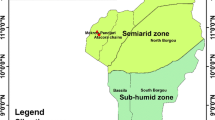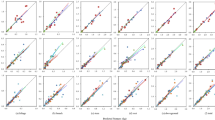Abstract
-
• In the present study, allometric biomass equations were developed for Nothofagus pumilio natural regeneration relating foliage, stem and branches (aboveground), roots (belowground), and total biomass to basal diameter and total height, based on destructive measurements of 390 naturally regenerated seedlings and saplings.
-
• Basal diameter was the most important independent variable in all equations and accounted for more than 88% of the variability of the different biomass components. The addition of height as a second independent variable slightly improved the predictions.
-
• The best-fit biomass components equations that were based on combinations of basal diameter and height as independent variables had adjusted R 2 values between 0.80 and 0.95 and a mean percent standard error between 21.3% and 26.6%.
-
• Based on the best-fit biomass equations and the natural regeneration development in a 14-years chronosequence in forests managed under shelterwood cuts, the total biomass varied from 0.9 Mg ha−1 (0.5 Mg ha−1 above and 0.4 Mg ha−1 belowground) for the primary forest, before the shelterwood cuts, to 19.5 Mg ha−1 (13.6 Mg ha−1 above and 5.9 Mg ha−1 belowground) 14 years after the seed cut. In the same period, carbon storage varied, from 0.5 Mg ha−1 to 9.8 Mg ha−1.
Résumé
-
• Dans la présente étude, des équations allométriques ont été élaborées pour prédire la biomasse du feuillage, des tiges, des branches et des racines, ainsi que de la biomasse totale, à partir du diamètre à la base et de la hauteur totale dans une régénération naturelle de Nothofagus pumilio. Des mesures destructives ont été réalisées sur 390 plants régénérés naturellement et de jeunes arbres.
-
• Le diamètre à la base était la plus importante variable indépendante dans toutes les équations et représentait plus de 88 % de la variabilité des différentes composantes de la biomasse. L’ajout de la hauteur en tant que deuxième variable indépendante, a légèrement amélioré les prédictions.
-
• Le meilleur ajustement des équations des composantes de la biomasse, fondées sur des combinaisons du diamètre à la base et de la hauteur comme variables indépendantes, a produit des valeurs de R 2 comprises entre 0,80 et 0,95 et un pourcentage moyen d’erreur standard compris entre 21,3 % et 26,6 %.
-
• En utilisant le meilleur ajustement des équations de biomasse, nous avons établi dans le cas d’une régénération naturelle étudiée à travers une chronoséquence de 14 années dans des forêts gérées en coupes d’abri, que l’accroissement en biomasse totale a varié entre 0,9 Mg ha−1 (0,5 pour les parties aériennes et 0,4 pour les racines) pour la forêt primaire, avant les coupes d’abri, et 19,5 Mg ha−1 (13,6 et 5,9, respectivement) 14 ans après la coupe d’ensemencement. Dans la même période, le stockage du carbone est passé de 0,5 à 9,8 Mg ha−1.
Similar content being viewed by others
References
Baskerville G.L., 1972. Use of logarithmic regression in the estimation of plant biomass. Can. J. For. Res. 2: 49–53.
Bartsch N. and Rapp C., 1994. Naturverjüngung von Nothofagus pumilio im Lochhieb. Verjüngungsökologische Untersuchungen im nord-patagonischen Bergwald Argentiniens. Forstarchiv 65: 119–130.
Bava J., 1999. Los bosques de lenga en Argentina. In: Donoso C. and Lara A. (Eds.), Silvicultura de los bosques nativos de Chile, Editorial universitaria, Santiago de Chile, pp. 273–296.
Bloomberg M., Mason E., and Jarvis P., 2008. Predicting seedling biomass of radiata pine from allometric variables. New For. 36: 103–114.
Caldentey J., Ibarra M., and Hernández P., 2001. Litter fluxes and decomposition in Nothofagus pumilio stands in the region of Magallanes, Chile. For. Ecol. Manage. 148: 145–157.
Cienciala E., Cerny M., Tatarinov F., and Apltauer J., 2006. Biomass functions applicable to Scots pine. Trees 20: 483–495.
Cole T.G. and Ewel J.J., 2006. Allometric equations for four valuable tropical tree species. For. Ecol. Manage. 229: 351–360.
Cuevas J.G., 2002. Episodic regeneration at the Nothofagus pumilio alpine timberline in Tierra del Fuego, Chile. J. Ecol. 90, 52–60.
Geudens G., Staelens J., Kint V., Goris R., and Lust N., 2004. Allometric biomass equations for Scots pine (Pinus sylvestris L.) seedlings during the first years of establishment in dense natural regeneration. Ann. For. Sci. 61: 653–659.
Haase R. and Haase P., 1995. Above-ground biomass estimates for invasive trees and shrubs in the Pantanal of Mato Grosso, Brazil. For. Ecol. Manage. 73: 29–35.
Jackson N.A., Griffiths H., and Zeroni M., 1995. Above-ground biomass of seedling and semi-mature Sesbania sesban, a multi-purpose tree species, estimated using allometric regressions. Agrofor. Syst. 29: 103–112.
Klein D., Fuentes J.P., Schmidt A., Schmidt H., and Schulte A., 2008. Soil organic C as affected by silvicultural and exploitative interventions in Nothofagus pumilio forests of the Chilean Patagonia. For. Ecol. Manage. 255: 3549–3555.
Martínez P.G., Lencinas M.V., Peri P.L., and Arena M., 2007. Photosynthetic plasticity of Nothofagus pumilio seedlings to light intensity and soil moisture. For. Ecol. Manage. 243: 274–282.
Parresol B., 1999. Assessing tree and stand biomass: A review with examples and critical comparisons. For. Sci. 45: 573–593.
Parresol B., 2001. Additivity of nonlinear biomass equations. Can. J. For. Res. 31: 865–878.
Pastor J., Aber J.D., and Melillo J.M., 1984. Biomass prediction using generalized allometric regressions for some northeast tree species. For. Ecol. Manage. 7: 265–274.
Rebertus A.J. and Veblen T.T., 1993. Structure and tree-fall gaps dynamics of old-growth Nothofagus forest in Tierra del Fuego, Argentina. J. Veg. Sci. 4: 641–654.
Rosenfeld J.M., Navarro Cerrillo R.M., and Guzman A.J.R., 2006. Regeneration of Nothofagus pumilio [Poepp. Et Endl.] Krasser forests after five years of seed tree cutting. J. Environ. Manage. 78: 44–51.
Schmidt H., Cruz G., Promis A., and Alvarez M., 2003. Transformación de los bosques de lenga vírgenes e intervenidos a bosques manejados. Universidad de Chile, Facultad de Ciencias Forestales, Publicaciones miscelaneas forestales No. 14, Santiago, Chile, 60 p.
Schmidt A., Klein D., Leuthold F., Schmidt H., and Schulte A., 2008. Anteil der Wurzelbiomasse an der Gesamtbaumbiomasse eines Lenga (Nothofagus pumilio) Naturwaldes im chilenischen Teil Patagoniens. Forstarchiv 79: 55–59.
Stewart J.L., Dunsdon A.J., Hellin J.J., and Hughes C.E., 1992. Wood biomass estimation of central american dry zone species. Tropical forestry papers No. 26, Oxford/UK, Oxford Forestry Institute.
Ter-Mikaelian M. and Korzukhin M., 1997. Biomass equations for sixty-five North American tree species. For. Ecol. Manage. 97: 1–24.
Ter-Mikaelian M. and Parker W., 2000. Estimating biomass of white spruce seedlings with vertical photo imagery. New For. 20: 145–162.
Veblen T.T., Hill R.S., and Read J., 1996. The ecology and biogeography of Nothofagus forests, Yale University Press, New Haven, 403 p.
Verwijst T., 1991. Logarithmic transformation in biomass estimation procedures: violation of the linearity assumption in regression analysis. Biomass Bioenergy 1: 175–180.
Wagner R.G. and Ter-Mikaelian M.T., 1999. Comparison of biomass component equations for four species of northern coniferous tree seedlings. Ann. For. Sci. 56: 193–199.
Weber M., 2001. Kohlenstoffspeicherung in Lenga-(Nothofagus pumilio) Primärwäldern Feuerlands und Auswirkungen ihrer Überführung in Wirtschaftswald auf den C-Haushalt, Kessel, Remagen, 119 p.
Williams R.A. and Mc Clenahen J.R., 1984. Biomass prediction equation for seedlings, sprouts, and saplings of ten central hardwood species. For. Sci. 30: 523–527.
Zianis D. and Mencuccini M., 2003. Aboveground biomass relationships for beech (Fagus moesiaca Cz.) trees in Vernio Mountain, Northern Greece, and generalised equations for Fagus sp. Ann. For. Sci. 60: 439–448.
Author information
Authors and Affiliations
Corresponding author
Rights and permissions
About this article
Cite this article
Schmidt, A., Poulain, M., Klein, D. et al. Allometric above-belowground biomass equations for Nothofagus pumilio (Poepp. & Endl.) natural regeneration in the Chilean Patagonia. Ann. For. Sci. 66, 513 (2009). https://doi.org/10.1051/forest/2009030
Received:
Accepted:
Issue Date:
DOI: https://doi.org/10.1051/forest/2009030




